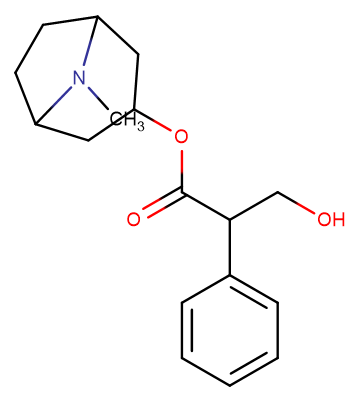
Atropine
CAS No. 51-55-8
Atropine ( DL-Hyoscyamine; Tropine tropate )
Catalog No. M14792 CAS No. 51-55-8
Atropine is a medication used to treat certain types of nerve agent and pesticide poisonings, some types of slow heart rate, and to decrease saliva production during surgery.
Purity : >98%(HPLC)
 COA
COA
 Datasheet
Datasheet
 HNMR
HNMR
 HPLC
HPLC
 MSDS
MSDS
 Handing Instructions
Handing Instructions
| Size | Price / USD | Stock | Quantity |
| 50MG | 34 | In Stock |


|
| 100MG | Get Quote | In Stock |


|
| 200MG | Get Quote | In Stock |


|
| 500MG | Get Quote | In Stock |


|
| 1G | Get Quote | In Stock |


|
Biological Information
-
Product NameAtropine
-
NoteResearch use only, not for human use.
-
Brief DescriptionAtropine is a medication used to treat certain types of nerve agent and pesticide poisonings, some types of slow heart rate, and to decrease saliva production during surgery.
-
DescriptionAtropine is a medication used to treat certain types of nerve agent and pesticide poisonings, some types of slow heart rate, and to decrease saliva production during surgery.
-
SynonymsDL-Hyoscyamine; Tropine tropate
-
PathwayEndocrinology/Hormones
-
TargetAChR
-
RecptormAChR
-
Research AreaNeurological Disease
-
Indication——
Chemical Information
-
CAS Number51-55-8
-
Formula Weight289.37
-
Molecular FormulaC17H23NO3
-
Purity>98%(HPLC)
-
Solubilitysoluble in Water
-
SMILESCN1C2CCC1CC(C2)OC(=O)C(CO)C1=CC=CC=C1
-
Chemical Name——
Shipping & Storage Information
-
Storage(-20℃)
-
ShippingWith Ice Pack
-
Stability≥ 2 years
Reference
1.Huang XP, et al. J Pharmacol Exp Ther. 1998 Sep; 286(3):1129-39.
molnova catalog


related products
-
Epiberberine (chlori...
Epiberberine chloride is an alkaloid isolated from Coptis chinensis acts as a potent AChE and BChE inhibitor and a non-competitive BACE1 inhibitor (IC50s: 1.07 6.03 and 8.55 μM).
-
Dichlorisone Acetate
It belongs to organophosphate compounds, used as a kind of common environmental health insecticide.
-
Zeaxanthin
Lutein and Zeaxanthin in neural tissue may have biological effects that include antioxidation, anti-inflammation, and structural actions.



 Cart
Cart
 sales@molnova.com
sales@molnova.com


